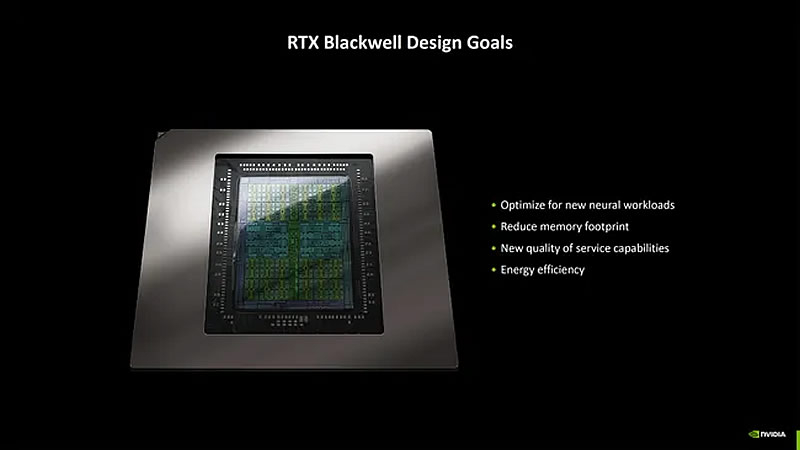Nvidia Reveals More Blackwell Architecture Details for GeForce RTX 50 Series Graphics Cards


At CES 2025, Nvidia revealed its new Blackwell GPU architecture, which will be the basis for the GeForce RTX 50 series graphics cards. The main emphasis was placed on neural computing, energy efficiency and support for modern technologies, including GDDR7 memory and the PCIe 5.0 interface, which provides maximum bandwidth.


Image source: NVIDIA
However, there have been significant changes to rendering and support for new interfaces. Blackwell’s fourth generation RT cores deliver twice the ray and triangle intersection speed of the Ada Lovelace architecture, which is especially important for games running Unreal Engine 5. GPU shaders have also been improved to work with Neural Shaders. In addition, Blackwell will be the first series of Nvidia graphics cards to support DisplayPort 2.1 UHBR20 (80 Gbps) and PCIe 5.0, although it is not yet known whether this applies to all Blackwell GPUs or just the flagship GeForce RTX 5090. Video encoding and decoding are also improved , including support for 4:2:2 streams.
Image source: NVIDIA
In terms of computing power, the GeForce RTX 5090 received a performance increase of up to 27% (1676 TFLOPS in FP8 format) compared to the GeForce RTX 4090, which, although significant, is not as significant in global terms as the transition from GeForce RTX 3090 to GeForce RTX 4090, where the improvement was 132%. A similar increase is observed in other indicators – 104.8 teraflops FP32 versus 82.6 for the GeForce RTX 4090, and may indicate that Nvidia has focused on more targeted improvements rather than a radical restructuring of the architecture.
On the memory side, Blackwell is moving to GDDR7, delivering higher bandwidth compared to the GDDR6 and GDDR6X used in previous generations. It is expected that most GeForce RTX 50 series video cards will receive memory with a bandwidth of 28 Gbps, and the GeForce RTX 5080 – 30 Gbps. The flagship GeForce RTX 5090 stood out even more – it received a 512-bit bus and 32 GB of memory, providing a huge increase in bandwidth.
Image source: NVIDIA
Another important innovation was the AI Management Processor. With its help, GPUs will be able to more efficiently distribute resources between various tasks, such as image scaling, frame generation and working with neural textures. This is especially true for games that actively use generative AI technologies.
Image source: NVIDIA
Blackwell has also improved power management, allowing it to enter and exit sleep mode faster, reducing energy costs at low loads. In general, according to experts, the Blackwell architecture promises a noticeable, but not revolutionary increase in performance. The main improvements are related to AI, neural rendering and energy efficiency. The GeForce RTX 5090 is expected to become the flagship of the new line, but its advantages over the GeForce RTX 4090 will be most noticeable in tasks related to artificial intelligence and neural technologies.
Recent Posts
Mobile GeForce RTX 5090 Disappoints Reviewers With Weak Performance Upgrades Over RTX 4090
Laptops with discrete GeForce RTX 50-series graphics cards will go on sale in a few…
- Mobile phones, smartphones, cellular communications, communicators, PDAs
- Technology and IT market. news
Google has finally decided when it will start selling the Pixel 9a
Google Pixel 9a was originally expected to go on sale this week. However, Google delayed…
The test version of Windows 11 received extended support for the ReFS file system – it will replace NTFS, but then
The latest Windows 11 Build 27823 introduces extended support for the new ReFS (Resilient File…
The developer of the legendary Pebble smartwatch has revealed details about the new Core 2 Duo and Core Time 2 watches
Pebble founder Eric Migicovsky recently unveiled his new smartwatches, powered by Pebble OS. The devices,…
Malicious CoffeeLoader Loader Discovered – It Hides from Antiviruses on Video Card and Uses Other Tricks
The dangerous CoffeeLoader program has been discovered - a malware loader that hides from antivirus…
Spectral JPEG XL image format introduced to efficiently store data even about invisible light
Intel scientists have developed a format for recording images called Spectral JPEG XL, which allows…